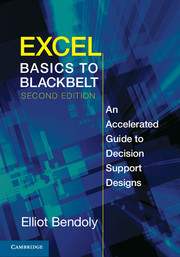Book contents
- Frontmatter
- Contents
- Associated Links
- Preface
- Section 1 Getting Oriented
- Section 2 Harvesting Intelligence
- Section 3 Leveraging Dynamic Analysis
- 8 Controlled Simulation Analysis
- 9 Simulation Search, Optimization, and Reporting
- 10 Visualizing Complex Analytical Dynamics
- Section 4 Advanced Automation and Interfacing
- Glossary of Key Terms
- Appendix: Shortcut (Hot Key) Reference
- Index
8 - Controlled Simulation Analysis
Published online by Cambridge University Press: 05 August 2013
- Frontmatter
- Contents
- Associated Links
- Preface
- Section 1 Getting Oriented
- Section 2 Harvesting Intelligence
- Section 3 Leveraging Dynamic Analysis
- 8 Controlled Simulation Analysis
- 9 Simulation Search, Optimization, and Reporting
- 10 Visualizing Complex Analytical Dynamics
- Section 4 Advanced Automation and Interfacing
- Glossary of Key Terms
- Appendix: Shortcut (Hot Key) Reference
- Index
Summary
We've talked about how difficult it can be to find or construct an optimal solution to real-world management problems, in which we're faced with nonlinear relationships and constraints that make it difficult to predict how specific decisions work together to impact performance. But in a certain way we've continued to simplify these real-world problems. There may be some shortcomings in the approaches we've taken in finding solutions, but what about the approaches we use to come up with the problems that we're trying to solve?
When we create a mathematical form to represent reality so that we can ultimately use analytics to provide an applicable real-world solution, are we missing something? And how much does this impact the real-world applicability and effectiveness of the solution we develop? These are critical questions for managers who want additional support in their decision making. Project managers don't want suggestions that come out of inappropriate assumptions.
What steps can we take to help ensure that we are, in fact, providing appropriate characterizations of reality when we structure problems and make sense of solutions? Although there are a lot of good places to start, one obvious place is an attempt to take into account the uncertainty associated with just about everything that takes place in the real world.
- Type
- Chapter
- Information
- Excel Basics to BlackbeltAn Accelerated Guide to Decision Support Designs, pp. 207 - 244Publisher: Cambridge University PressPrint publication year: 2013



